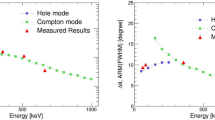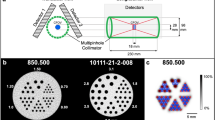Abstract
THE pinhole camera method of taking gamma-radioautographs, though it has been described in the literature1, has had very little use because of the long exposure times which are necessary even when the most sensitive radiographic films are used. An intensifying screen for use with the pinhole camera has now been developed which has made it possible to reduce the exposure time considerably. The screen consists of a large, flat crystal of thallium-activated sodium iodide. The gamma-rays produce scintillations in the crystal which in turn affect the photographic plate. This method has made it possible to take an in vivo gamma-ray pinhole radioautograph of a tumour containing 20 millicuries of iodine-131.
This is a preview of subscription content, access via your institution
Access options
Subscribe to this journal
Receive 51 print issues and online access
$199.00 per year
only $3.90 per issue
Buy this article
- Purchase on Springer Link
- Instant access to full article PDF
Prices may be subject to local taxes which are calculated during checkout
Similar content being viewed by others
References
Copeland, D. Eugene, and Benjamin, Emanuel W., Nucleonics, 5, No. 2, 44 (1949).
Author information
Authors and Affiliations
Rights and permissions
About this article
Cite this article
ANGER, H. Use of a Gamma-Ray Pinhole Camera for in vivo Studies. Nature 170, 200–201 (1952). https://doi.org/10.1038/170200b0
Issue Date:
DOI: https://doi.org/10.1038/170200b0
This article is cited by
-
It’s Not What You Take Up, It’s What You Keep: How Discoveries from Diverse Disciplines Directed the Development of the FDG PET/CT Scan
Digestive Diseases and Sciences (2022)
-
Functional imaging for regenerative medicine
Stem Cell Research & Therapy (2016)
-
Hal Oscar Anger, D.Sc. (hon.) (1920–2005): a pioneer in nuclear medicine instrumentation
Radiological Physics and Technology (2014)
Comments
By submitting a comment you agree to abide by our Terms and Community Guidelines. If you find something abusive or that does not comply with our terms or guidelines please flag it as inappropriate.



